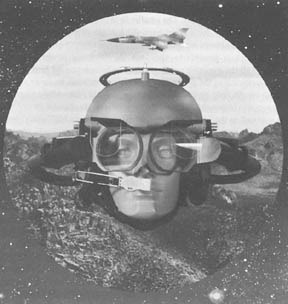Chapter 13: Flight Simulation
13.5 Military


The U.S. Navy maintained an active simulation activity, particularly at their Naval Training Systems Center in Florida. Most notable was the early development on their VTRS, or Visual Technology Research Simulator. This simulator was an example of a “target tracked” system, which placed an image of the air-to-air combat target dynamically in a larger scene, in this case on a spherical screen surrounding the trainer cockpit. In the interest of computation speed, the area of most visual interest (the target and its nearby surroundings) was rendered in higher detail, and inset into a lower resolution background display representing the surrounding terrain outside of the interest field of view.
NTSC also developed a head mounted display for American Airlines that used the target tracking approach that was also developed by Singer-Link in their ESPRIT (Eye-Slaved Projected Raster Inset) system.The NTSC system used eye and head tracking technologies, and projected from a lens on the helmet, so the higher resolution image was always coordinated with the pilot’s view.
The Air Force was also interested in low altitude simulation of high resolution, high detail terrain. Their ASPT (Advanced Simulator for Pilot Training) installed in 1974 at Williams AFB in Arizona was one of the first examples of a multiple display, multiple CGI channel “butted” display system, which was the model for most simulators built during the 1980s and 1990s. The field of view was divided between multiple CRTs surrounding the pilot, each fed with a signal from an independent but synchronized computer image generator. By aligning the boundary of one display with that of the adjacent, it gave the feel of a continuous image. The ASPT used seven CRTs with complex optics to eliminate overlapped images, in what they called the “Pancake Window” (Farrand Optical Company). Each pentagonal window provided more than an 86° field of view.

An alternate approach emerged from the Air Force Resource Laboratory. The Pancake Window mosaic display was becoming difficult to maintain. Seeking a low cost, full color replacement for the dim, monochrome Pancake Window led to experiments with rear projection screens and CRT projectors. A bright, clear real image was formed at approximately arm’s length from the pilot’s eye. An example of this technology was the Boeing VIDS (Visual Integrated Display System.)
The E&S CT5 and CT6 systems are configured like the ASPT system. The early CT5, coupled with the Rediffusion physical simulator, cost around $20M. Other similar systems included the GE Compuscene IV made for Martin Marietta and the DIG from Singer-Link.
